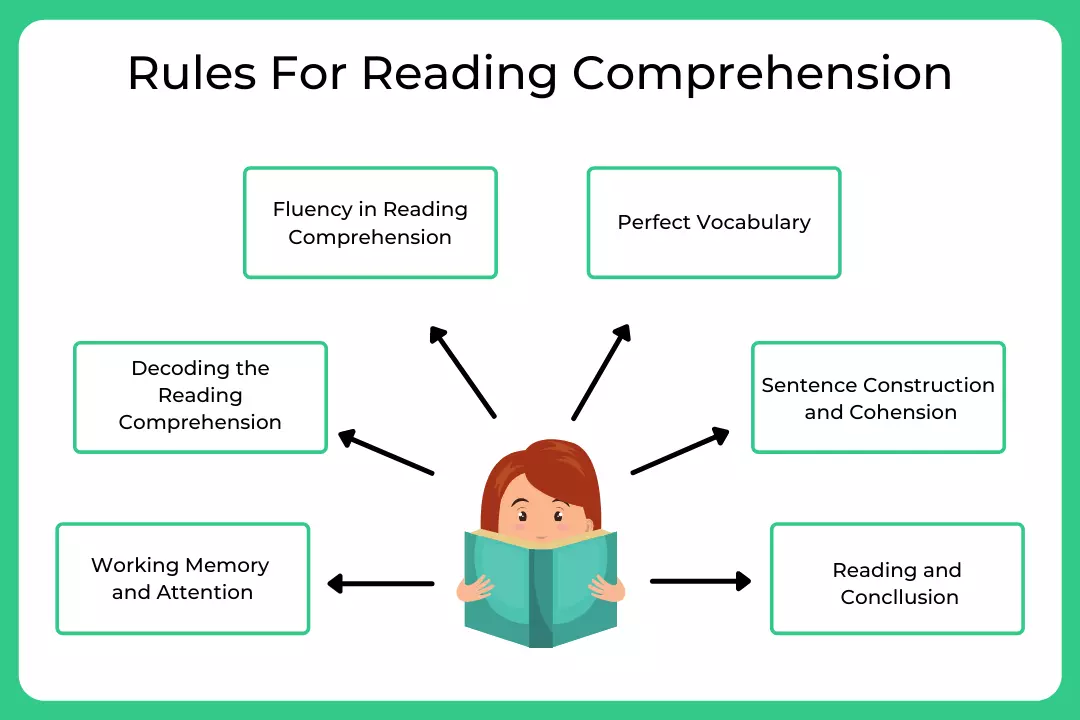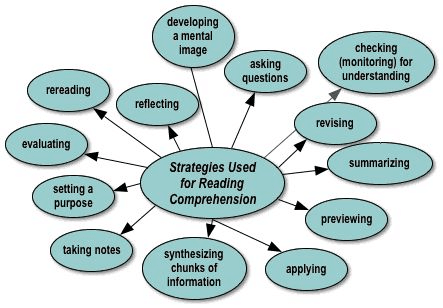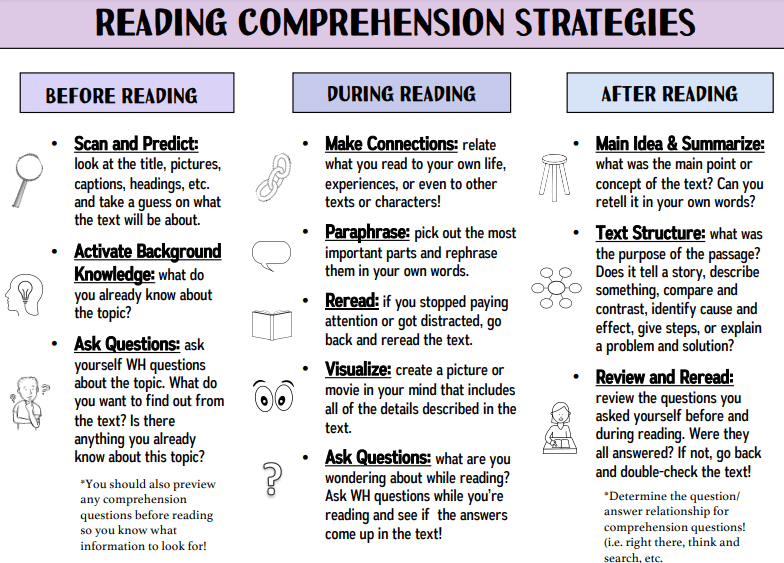Strategy to Solve RC Questions | General Aptitude for GATE - Mechanical Engineering PDF Download
| Table of contents |

|
| Tackling & Solving a Reading Comprehension question |

|
| Detailed General Strategy to Solve RC Questions |

|
| How to Read A Passage in Exam? |

|
| Practice Passage |

|
Tackling & Solving a Reading Comprehension question
Practice is the key!
Solving RC practice exercises regularly helps to develops confidence and gives an exposure to the nuances of RC.
- An aspirant is suggested to find out the main idea of the articles in the editorial section of the newspapers so that identifying the main idea comes naturally to you as it is integral to answering questions in Different competitive exams especially inferential ones.
- Below are Some Quick Tips to Solve “Reading Comprehension Questions”

Step 1. Skim through the Questions first
Step 2. Take out the “Main Point” of the Passage
Step 3. Understand the structure of the Passage
Step 4. Extract usable Information
Step 5. Start attempting
- Find below the detailed strategy to solve Reading Comprehension questions
Detailed General Strategy to Solve RC Questions
- Increasing your motivation while again and again asking yourself what is your goal, why are you reading what are its benefits in long term.
- Decrease distractions when reading – Avoid external thoughts – keep away mobiles, TV, friends etc – Choose a peaceful and lonely space to read.

- Create notes of keywords into your mind by reading aloud (only the keywords) Don’t jump to the dictionary.
- Avoid regression as discussed above rather try to understand the contextual meaning of difficult words.
- Do the critical reading of the passage. Keep questioning attitude in the back of your mind.
- Do reason with each sentence! Keep WHAT-WHY-HOW-WHERE always in back up of your mind.
- Try to predict the next sentence. Try to bring conclusions/inferences from what you have read.
It’s more about comprehension than reading!
- As seen For the last three years, Reading Comprehension (RC) questions have had a lion’s share in the exam. With 70% of questions devoted to this category, it is not surprising that you, have realized that your reading habits will play a huge role in determining how well you perform in this critical section. Which leads to the important question – What should one read in the days leading up to the exam?
- A quick search on Google reveals that many of the reading comprehension passages have been taken from international publications such as The New York Times (https://www.nytimes.com/), The Guardian (https://www.theguardian.com), the BBC website (http://www.bbc.com/) and TIME magazine (http://time.com/). And this is not a new trend. RC passages had been taken from The Guardian for exams conducted in 2005 and 2006 as well. The implication is clear. The IIMs expect future managers to be comfortable with the language employed on international forums and not just within India.
- It is strongly suggested that the aspirants should make it a habit to scan these publications on a regular basis. Doing this will help them to update their vocabulary level in line with the expectations of the paper setters and expose them to international issues which they may not have come across earlier.
- While going through these publications, the aspirants should particularly focus on the articles that express opinions and the editorials of these publications. This will provide them with the additional benefit of being updated on important issues affecting the international arena. This should prove invaluable for the next stage in the admission process – group discussions, personal interviews, essays etc.
- An effort should be made to read up on the topics away from their comfort zones. RC passages covered a range of different topics. Exposure to an eclectic range of topics will help the yous stabilize their reading speed and improve their level of comprehension, even in topics unfamiliar to them.
How to Read A Passage in Exam?
- Focus on only keywords - chosen keywords must be such that it reflects the message of the full sentence. (practice it)
- Make logical linkages between keywords as you read on the passage.
- Do reason with these keywords in the backup of your mind as you read on. (It will help you retain keywords in your memory)
- Finally, you get a mental map of the full passage containing keywords only.
Example: Let us take a small Passage
As financial markets worldwide tumbled over concerns that Greece would default on its debt to the troika comprising the European Commission, the European Central Bank and the International Monetary Fund, the people of Greece were being presented with a Hobson’s choice by its government led by the leftist party, Syriza. In the midst of intense negotiations with representatives of the troika over rolling over debt payments, the Syriza government sought to extend the deadline for payments.
➤ Key Words from Paragraph
- Tumbled
- Greece default
- Leftist party
- Extend the deadline
➤ Advantages of the Above Approach
As you have mental map (rough idea) of a passage, you can easily give answers for following type of questions:
- Give a Suitable title of passage.
- Main idea discussed by author in the passage.
- Tone/sense of passage.
- Further key words also help you locate the part of the passage, in which you will find answers for specific questions.
➤ Strategy While Attempting Questions
- Read passage with above approach (get a complete summary of passage in your mind)
- Apart from passage reading also focus on keywords while reading a question statement or answer options. It keep your focus intact.
- Try to eliminate the least possible answers. (as you have a complete sense of passage) .
- Next, if you cannot answer the question directly → refer back to passage → try to locate answers in the passage.
- If you find the answer, tick it.
- If you did not find → guess the answer only if you already eliminated at least 2 answer options. Otherwise don’t make a blind guess.
- If a question asks about a particular line then read at least 2 sentences before and after the line in question. This will help you understand the idea of where the point started and where the author is going with it.
Example
“A pioneering figure in modern sociology, French social theorist Emile Durkheim examined the effect of societal cohesion on emotional well-being. Believing that scientific methods should be applied to the study of society, Durkheim studied the levels of integration in various social formations and the impact that such cohesion had on individuals within the group. He postulated that social groups with high levels of integration serve to buffer their members from frustrations and tragedies that could otherwise lead to desperation and self-destruction. Integration, in Durkheim’s view, generally arises through shared activities and values. Durkheim distinguished between mechanical solidarity and organic solidarity in classifying integrated groups. Mechanical solidarity dominates in groups in which individual differences are minimized and group devotion to a common goal is high. Durkheim identified mechanical solidarity among groups with little division of labour and high degrees of cultural similarities, such as among more traditional and geographically isolated groups. Organic solidarity, in contrast, prevails in groups with high levels of individual differences, such as those with a highly specialized division of labour. In such groups, individual differences are a powerful source of connection rather than of division. Because people engage in highly differentiated ways of life “they are by necessity interdependent. In these societies, there is greater freedom from some external controls, but such freedom occurs in concert with the interdependence of individuals, not in conflict with it. Durkheim realized that societies may take many forms and, consequently, that group allegiance can manifest itself in a variety of ways. In both types of societies outlined previously, however, Durkheim stressed that adherence to a common set of assumptions about the world was a necessary prerequisite for maintaining group integrity and avoiding social decay.
Ques: Which of the following is NOT a feature of an organic societal formation, according to Emile Durkheim?
(a) Members are buffered from individual frustration that would lead the individual to cease being a productive member of society.
(b) Citizens operate independently in their daily lives, but toward a common overall goal.
(c) Each person must come to accept a series of assumptions that form a collective worldview shared by the formation.
(d) Workers have an even division of labor and share the work of common tasks.
(e) Individual differences are celebrated and have a strengthening effect on the society.
Solution:
STEP 1: Read the passage strategically
- As the author sets forth the criteria for Emile Durkheim’s theory of social cohesion, he defines two models of social solidarity by introducing qualities that are common to both constructs before addressing the differences between the two.
- The passage concludes with a prerequisite for social cohesion common to both models. The two models have similarities, but note that the author is contrasting them with one another.
STEP 2: Analyze the question stem
- This question asks which choice is NOT a feature of the organic solidarity model. Normally, you would approach this question type by researching what the passage says are features of the organic solidarity model and eliminating answers that mention them.
- In this case, since the passage contrasts two models of societal formation, the correct answer will likely be a feature of the opposed mechanical solidarity model.
STEP 3: Research the relevant text in the passage
- The relevant text is the part of the passage that discusses the features of the two types of societal formation. Since the question asks you to find what is not common to the organic solidarity model, research the portion that defines the mechanical solidarity model as well.
- The author emphasizes one distinction between the models: the lack of a specialized labor force in the mechanical solidarity model versus the presence of a specialized division of labor in the organic solidarity model.
STEP 4: Make a prediction
- Apply your research to the “call” of the question stem. The correct answer here is a feature not found in organic solidarity groups. Since the author highlights the organic solidarity model’s highly specialized division of labor, predict that the correct answer will describe a case in which labor is not differentiated. Now, check the answers to find the choice that matches this prediction.
STEP 5: Evaluate the answer choices
- Choice (d) matches your prediction quite well. Societies that distribute labor evenly and parcel out common tasks among everyone and do not use a specialized labor force. They fit the mechanical solidarity model, not the organic solidarity one. ”
- Choice (a) and choice (c) is found among the descriptions for both forms of Durkheim’s societal formations, the first early in the paragraph and the other toward the end, so they are wrong. Within the section discussing organic solidarity societies, you can find, as part of the definition, differently worded forms of both choice (b) and choice (e).
 |
Download the notes
Strategy to Solve RC Questions
|
Download as PDF |
Practice Passage
When I was little, children were bought two kinds of ice cream, sold from those white wagons with canopies made of silvery metal: either the two-cent cone or the four-cent ice-cream pie. The two-cent cone was very small, in fact it could fit comfortably into a child’s hand, and it was made by taking the ice cream from its container with a special scoop and piling it on the cone. Granny always suggested I eat only a part of the cone, then throw away the pointed end, because it had been touched by the vendor’s hand (though that was the best part, nice and crunchy, and it was regularly eaten in secret, after a pretence of discarding it).
The four-cent pie was made by a special little machine, also silvery, which pressed two disks of sweet biscuit against a cylindrical section of ice cream. First, you had to thrust your tongue into the gap between the biscuits until it touched the central nucleus of ice cream; then, gradually, you ate the whole thing, the biscuit surfaces softening as they became soaked in creamy nectar. Granny had no advice to give here: in theory, the pies had been touched only by the machine; in practice, the vendor had held them in his hand while giving them to us, but it was impossible to isolate the contaminated area.
I was fascinated, however, by some of my peers, whose parents bought them not a four-cent pie but two two-cent cones. These privileged children advanced proudly with one cone in their right hand and one in their left, and expertly moving their head from side to side, they licked first one, then the other. This liturgy seemed to me so sumptuously enviable, that many times I asked to be allowed to celebrate it. In vain. My elders were inflexible: a four-cent ice, yes; but two two-cent ones, absolutely no.
As anyone can see, neither mathematics nor economy nor dietetics justified this refusal. Nor did hygiene, assuming that in due course the tips of both cones were discarded. The pathetic, and obviously mendacious, justification was that a boy concerned with turning his eyes from one cone to the other was more inclined to stumble over stones, steps, or cracks in the pavement. I dimly sensed that there was another secret justification, cruelly pedagogical, but I was unable to grasp it.
Today, citizen and victim of a consumer society, a civilization of excess and waste (which the society of the thirties was not), I realize that those dear and now departed elders were right. Two two-cent cones instead of one at four cents did not signify squandering, economically speaking, but symbolically they surely did. It was for this precise reason, that I yearned for them: because two ice creams suggested excess. And this was precisely why they were denied to me: because they looked indecent, an insult to poverty, a display of fictitious privilege, a boast of wealth. Only spoiled children ate two cones at once, those children who in fairy tales were rightly punished, as Pinocchio was when he rejected the skin and the stalk. And parents who encouraged this weakness, appropriate to little parvenus, were bringing up their children in the foolish theatre of “I’d like to but I can’t.” They were preparing them to turn up at tourist-class check-in with a fake Gucci bag bought from a street peddler on the beach at Rimini.
Nowadays the moralist risks seeming at odds with morality, in a world where the consumer civilization now wants even adults to be spoiled and promises them always something more, from the wristwatch in the box of detergent to the bonus bangle sheathed, with the magazine it accompanies, in a plastic envelope. Like the parents of those ambidextrous gluttons I so envied, the consumer civilization pretends to give more, but actually gives, for four cents, what is worth four cents. You will throwaway the old transistor radio to purchase the new one, that boasts an alarm clock as well, but some inexplicable defect in the mechanism will guarantee that the radio lasts only a year. The new cheap car will have leather seats, double side mirrors adjustable from inside, and a panelled dashboard, but it will not last nearly so long as the glorious old Fiat 500, which, even when it broke down, could be started again with a kick. The morality of the old days made Spartans of us all, while today’s morality wants all of us to be Sybarites.
|
194 videos|168 docs|152 tests
|
FAQs on Strategy to Solve RC Questions - General Aptitude for GATE - Mechanical Engineering
| 1. How can I effectively tackle and solve reading comprehension questions? |  |
| 2. What is a general strategy to solve reading comprehension questions? |  |
| 3. How should I read a passage during an exam? |  |
| 4. What are some frequently asked questions about tackling and solving reading comprehension questions? |  |
| 5. What are some highly searched questions on Google related to reading comprehension strategies for exams? |  |























